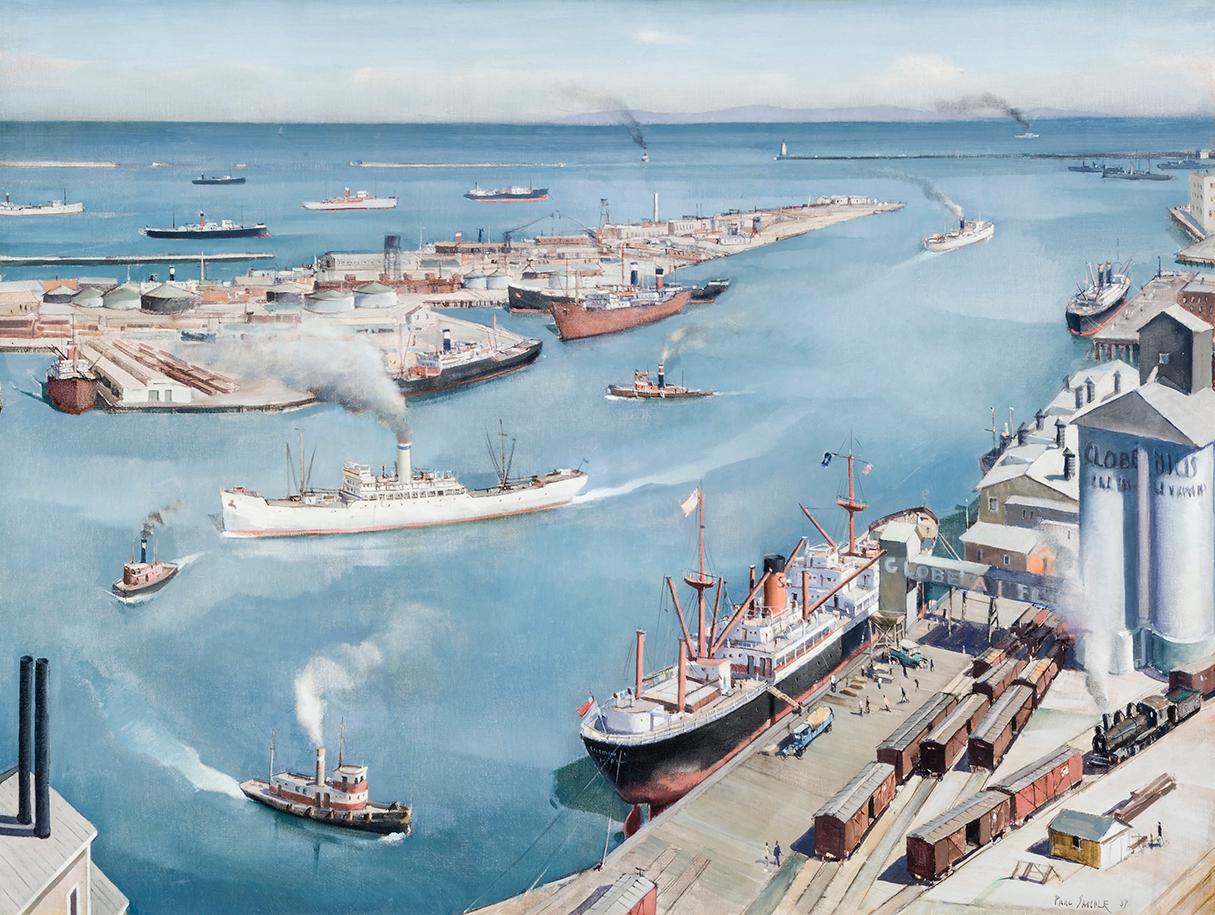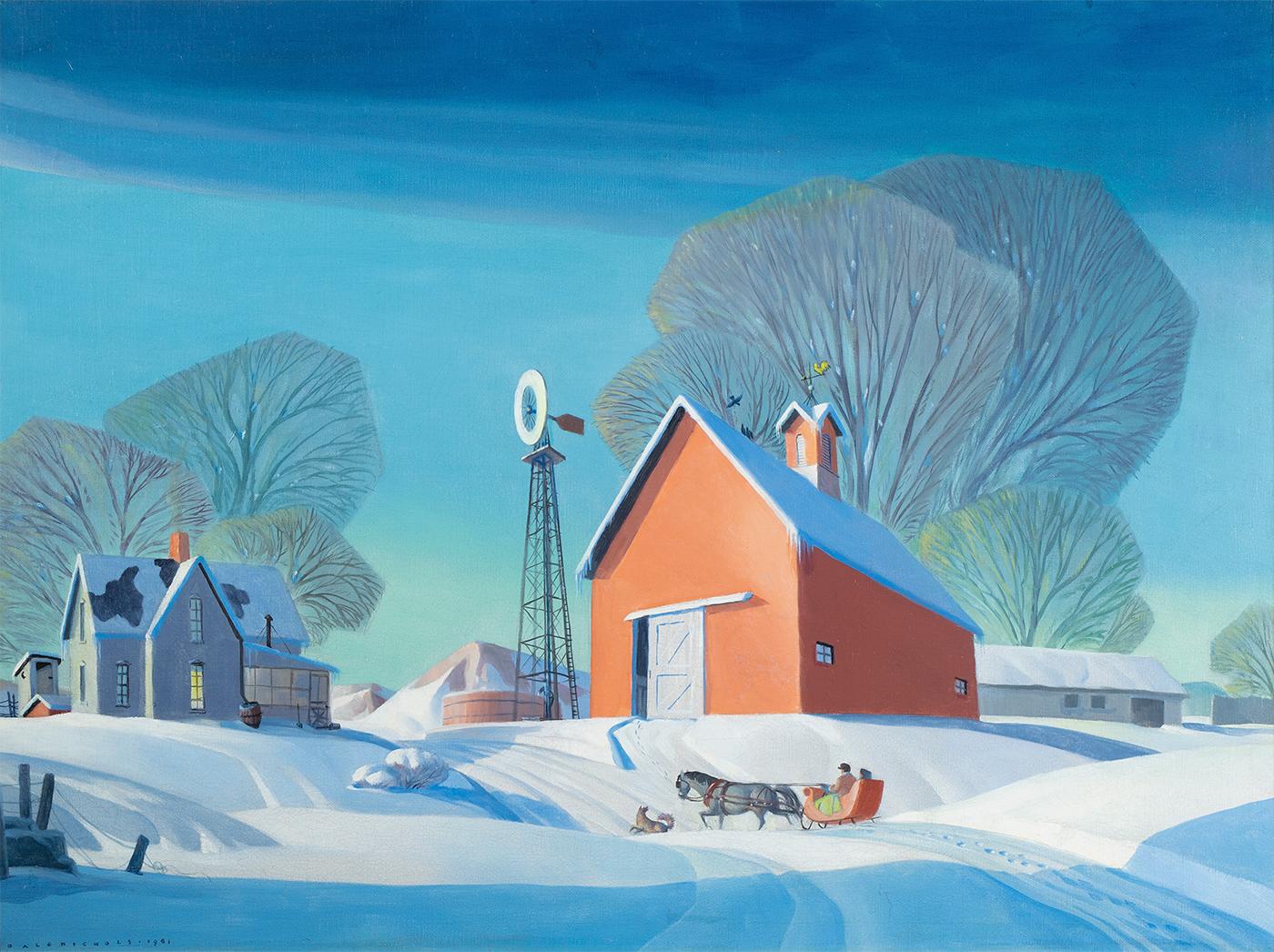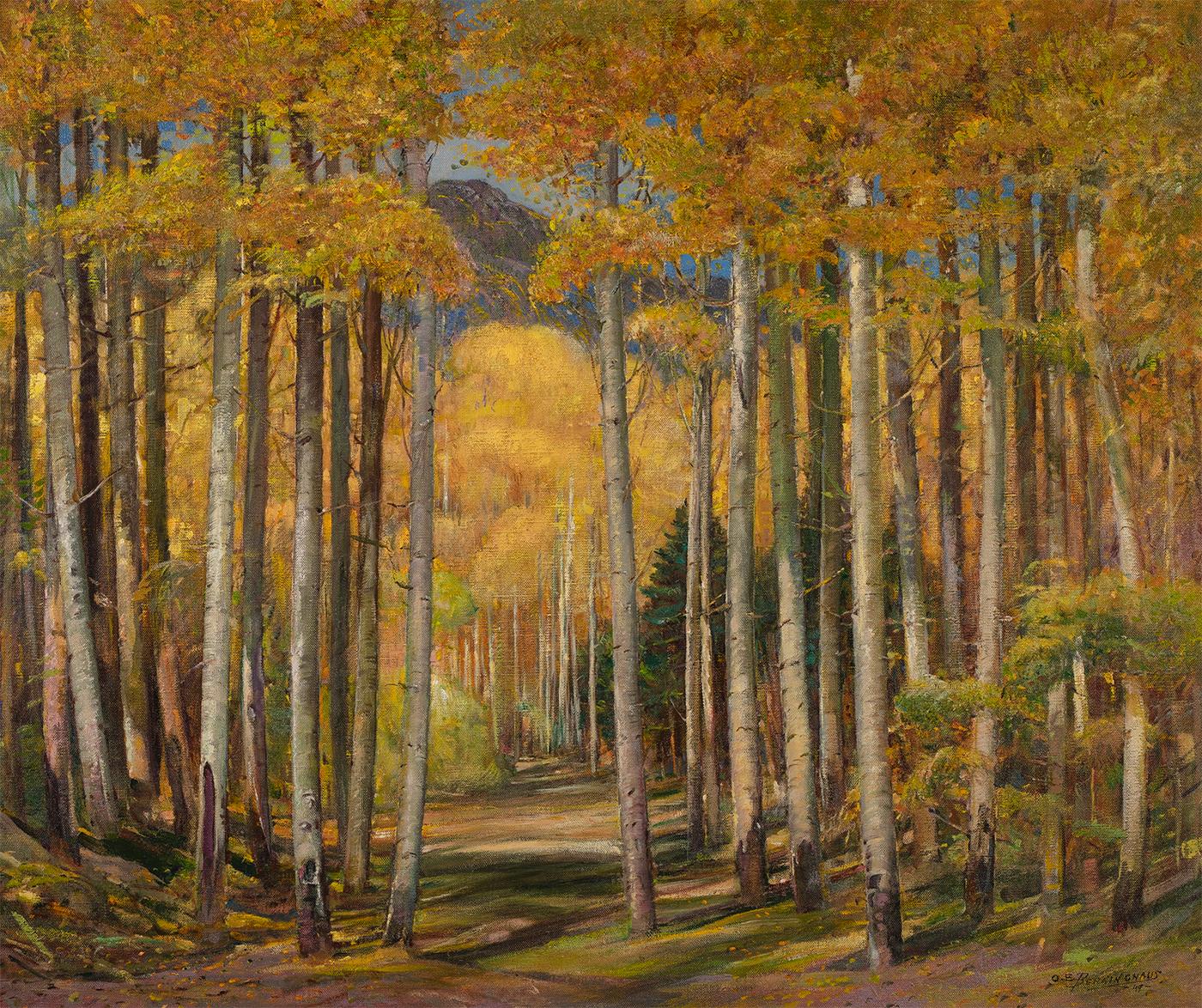Items Similar to Colorful Modernist Duck/Geese Hunting Oil Painting, dated 1966 - Hudson Bay Area
Want more images or videos?
Request additional images or videos from the seller
1 of 9
UnknownColorful Modernist Duck/Geese Hunting Oil Painting, dated 1966 - Hudson Bay Area1966
1966
About the Item
This colorful painting of two duck hunters on a trip to the eastern side of the Hudson Bay in Canada is done in a modernist style. Unsigned, the work includes an abstracted rocky coastline against the blue waters of the open bay. The rocks are rendered in convincingly colorful shades of grey, green, purple and blue. As a modernist work from the 1960’s, the artist portrays the hunters as recognizable forms within the outdoor setting. A group of ducks, or perhaps geese, are flying in from the south and into their view. . The sky is generally cloudy, with a brighter horizon over the water.
The painting is dated 1966, and placed “Povungnituk” in the lower right area, where one would expect to see the signature as well. In very small pencilled lettering on the painted wood frame, the artist wrote “Fasten your seat belt George- here they come!” That is an unusual notation and location for it, especially on the front side and on the frame itself.
Povungnituk is an Inuit community in Northern Quebec located where the River by the same name empties into the Hudson Bay. It was established by a Hudson Bay Company Trading Post in 1921 and has grown to a village of over 2,000 today.
The oil on board measures 10” x 14” and with the original oak painted frame 12 1/2” x 16 1/2” overall. Both the painting and frame are in very good condition and ready to hang on the wall of your choice.
Although the work is unsigned, it possesses a very competent artistic manner and style. The paint is confidently applied and the overall composition good. An unusual mid century hunting painting it surely is.
- Creation Year:1966
- Dimensions:Height: 10 in (25.4 cm)Width: 14 in (35.56 cm)Depth: 2 in (5.08 cm)
- Medium:
- Movement & Style:
- Period:
- Condition:
- Gallery Location:Baltimore, MD
- Reference Number:1stDibs: LU2396213961582
About the Seller
5.0
Gold Seller
These expertly vetted sellers are highly rated and consistently exceed customer expectations.
Established in 1995
1stDibs seller since 2023
15 sales on 1stDibs
Typical response time: <1 hour
- ShippingRetrieving quote...Ships From: Baltimore, MD
- Return PolicyA return for this item may be initiated within 3 days of delivery.
More From This SellerView All
- Vintage Modernist Landscape Painting, Monument Valley Arizona, listed artistLocated in Baltimore, MDAlthough born in Ohio at the end of the 19th century, Martin Sabransky studied art at Randolph Macon College in Virginia. He began his career path moving west, by first going to Kans...Category
Mid-20th Century American Modern Landscape Paintings
MaterialsOil
- Vintage Southern California Abstract Landscape Painting - Katharyn Truesdell 70sLocated in Baltimore, MDKatharyn Gwendoln Truesdell - (American; 1909-1996) This colorful painting depicts a Southern California valley, likely near Sun City, over the mountains from Los Angeles and San Di...Category
1970s American Modern Landscape Paintings
MaterialsOil
- Vintage Rockwell Kent Copy of "Vermont Winter 1921" Oil on Canvas Painting, 1960By Rockwell KentLocated in Baltimore, MDThis large painting is a ca. 1960 copy of a famous Rockwell Kent painting that was executed in Vermont in 1921. The work is oil on canvas and well represents the original image, tho...Category
1960s American Modern Landscape Paintings
MaterialsOil
- Vintage Southwest (California?) Impressionist Painting, Lily S. Converse ca 1940Located in Baltimore, MDThis is a very stylized Southwest landscape that appears to document a small church that existed at one time, perhaps in the Palm Springs or Santa Fe area. It is very reminiscent of...Category
1940s American Modern Landscape Paintings
MaterialsOil
- Stylish Hawaiian Luau Oil Painting by Listed artist Mario Larrinaga (1895-1979)Located in Baltimore, MDMario Larrinaga was born in Baja California in 1895 and moved with his brother to Los Angeles in 1909. He had no formal training in art, but had natural talent that was noticed by local movie studios. He was hired by Universal Studios as a designer, art director and creator of background scenes. He produced some of the background effects for King Kong in 1933. After a career in set design and illustration he focused on painting for pleasure in California, Mexico and Hawaii. He belonged to local art clubs and exhibited his works often. This stylized modernist work was likely created around 1960. It is oil on wood panel and of a horizontal format, 18” x 36”. It portrays a procession of seemingly Hawaiian natives...Category
Mid-20th Century American Modern Figurative Paintings
MaterialsOil
- Rare Southern Painting of the French Broad River, North Carolina ca 1890Located in Baltimore, MDThis is an unsigned, but rare, late 19th century oil on canvas of a view of the French Broad River in North Carolina. It is amongst the world’s oldest rivers. The scene depicted is m...Category
1880s Romantic Landscape Paintings
MaterialsOil
You May Also Like
- San Pedro HarborBy Paul SampleLocated in New York, NYIt is infrequent, to say the least, that a diagnosis of tuberculosis proves fortuitous, but that was the event, in 1921, that set Paul Starrett Sample on the road to becoming a professional artist. (The best source for an overview of Sample’s life and oeuvre remains Paul Sample: Painter of the American Scene, exhib. cat., [Hanover, New Hampshire: Hood Museum of Art, 1988] with a detailed and definitive chronology by Sample scholar, Paula F. Glick, and an essay by Robert L. McGrath. It is the source for this essay unless otherwise indicated.) Sample, born in Louisville, Kentucky, in 1896 to a construction engineer and his wife, spent his childhood moving with his family to the various locations that his father’s work took them. By 1911, the family had landed in Glencoe, Illinois, settling long enough for Paul to graduate from New Trier High School in 1916. Sample enrolled at Dartmouth College, in Hanover, New Hampshire, where his interests were anything but academic. His enthusiasms included the football and basketball teams, boxing, pledging at a fraternity, and learning to play the saxophone. After the United States entered World War I, Sample, to his family’s dismay, signed on for the Naval Reserve, leading directly to a hiatus from Dartmouth. In 1918 and 1919, Sample served in the U.S. Merchant Marine where he earned a third mate’s license and seriously contemplated life as a sailor. Acceding to parental pressure, he returned to Dartmouth, graduating in 1921. Sample’s undergraduate life revolved around sports and a jazz band he formed with his brother, Donald, two years younger and also a Dartmouth student. In November 1933, Sample summarized his life in a letter he wrote introducing himself to Frederick Newlin Price, founder of Ferargil Galleries, who would become his New York art dealer. The artist characterized his undergraduate years as spent “wasting my time intensively.” He told Price that that “I took an art appreciation course and slept thru it every day” (Ferargil Galleries Records, circa 1900–63, Archives of American Art, Smithsonian Institution, available on line). In 1920, Donald Sample contracted tuberculosis. He went for treatment to the world-famous Trudeau Sanitorium at Saranac Lake, in New York State’s Adirondack Mountains for the prescribed regimen of rest, healthful food, and fresh air. Visiting his brother in 1921, Paul also contracted the disease. Tuberculosis is highly contagious, and had no certain cure before the development of streptomycin in 1946. Even for patients who appeared to have recovered, there was a significant rate of recurrence. Thus, in his letter to Price, Sample avoided the stigma conjured by naming the disease, but wrote “I had a relapse with a bad lung and spent the next four years hospitalized in Saranac Lake.” The stringent physical restrictions imposed by adherence to “the cure” required Sample to cultivate an alternate set of interests. He read voraciously and, at the suggestion of his physician, contacted the husband of a fellow patient for instruction in art. That artist, then living in Saranac, was Jonas Lie (1880–1940), a prominent Norwegian-American painter and an associate academician at the National Academy of Design. Lie had gained renown for his dramatic 1913 series of paintings documenting the construction of the Panama Canal (The Metropolitan Museum of Art, New York; United States Military Academy, West Point, New York). Primarily a landscape artist, Lie had a particular affinity for scenes with water. His paintings, impressionistic, atmospheric, and brushy, never strayed from a realistic rendering of his subject. Sample regarded Lie as a mentor and retained a lifelong reverence for his teacher. Sample’s early paintings very much reflect Lie’s influence. ` In 1925, “cured,” Sample left Saranac Lake for what proved to be a brief stay in New York City, where his veteran’s benefits financed a commercial art course. The family, however, had moved to California, in the futile hope that the climate would benefit Donald. Sample joined them and after Donald’s death, remained in California, taking classes at the Otis Art Institute in Los Angeles. In Sample’s account to Price, “I couldn’t stomach the practice of painting a lot of High Sierras and desert flowers which seemed to be the only kind of pictures that were sold here so I got a job teaching drawing and painting at the art school of the University of Southern California.” Initially hired as a part-time instructor, Sample progressed to full-time status and ultimately, by the mid-1930s, to the post of Chairman of the Fine Art Department. Sample, however, did not want to wind up as a professor. “Teaching is all right in small doses,” he wrote, “but I have a horror of drifting into being a college professor and nothing more.” At the same time as he taught, Sample began to exhibit his work in a variety of venues at first locally, then nationally. Though he confessed himself “a terrible salesman,” and though occupied with continued learning and teaching, Sample was nonetheless, ambitious. In 1927, he wrote in his diary, “I am eventually going to be a painter and a damned good one. And what is more, I am going to make money at it” (as quoted by Glick, p. 15). In 1928, Sample felt sufficiently solvent to marry his long-time love, Sylvia Howland, who had also been a patient at Saranac Lake. The Howland family were rooted New Englanders and in summertime the Samples regularly traveled East for family reunion vacations. While the 1930s brought serious hardship to many artists, for Paul Sample it was a decade of success. Buttressed by the financial safety net of his teacher’s salary, he painted realist depictions of the American scene. While his work addressed depression-era conditions with a sympathetic eye, Sample avoided the anger and tinge of bitterness that characterized much contemporary realist art. Beginning in 1930, Sample began to exhibit regularly in juried exhibitions at important national venues, garnering prizes along the way. In 1930, Inner Harbor won an honorable mention in the Annual Exhibition of the Art Institute of Chicago. That same year Sample was also represented in a show at the Albright-Knox Gallery in Buffalo and at the Biennial Exhibition of the Corcoran Gallery of Art, Washington, D.C. In 1931, Dairy Ranch won the second Hallgarten Prize at the Annual Exhibition of the National Academy of Design, in New York. Sample also made his first appearances at the Carnegie Institute, Pittsburgh, and The Pennsylvania Academy of the Fine Arts, Philadelphia. In 1936, Miner’s Resting won the Temple Gold Medal at the Pennsylvania Academy’s Annual Exhibition. Always interested in watercolor, in 1936, Sample began to send works on paper to exhibitions at the Whitney Museum, New York. While participating in juried exhibitions, Sample also cultivated commercial possibilities. His first New York art dealer was the prestigious Macbeth Gallery in New York, which included his work in a November 1931 exhibition. In 1934, Sample joined the Ferargil Galleries in New York, after Fred Price arranged the sale of Sample’s Church Supper to the Michele and Donald D’Amour Museum of Fine Arts in Springfield, Massachusetts. In 1937, The Metropolitan Museum of Art purchased Sample’s Janitor’s Holiday from the annual exhibition of the National Academy of Design, a notable honor. As prestigious as this exhibition schedule may have been, by far Sample’s most visible presence in the 1930s and 1940s was the result of his relationship with Henry Luce’s burgeoning publishing empire, Time, Inc. Sample’s first contribution to a Luce publication appears to have been another San Pedro...Category
20th Century American Modern Landscape Paintings
MaterialsCanvas, Oil
- Till the Clouds Roll By 1945 Frank Sinatra Mid Century Modern Hollywood Film WPABy Richard WhorfLocated in New York, NYTill the Clouds Roll By 1945 Frank Sinatra Mid Century Modern Hollywood Film WPA TILL THE COULDS ROLL BY (Film Set), oil on canvas, 20 x 24 inches signed “Richard Whorf” lower right and signed and dated on the verso “R. Whorf/ Dec. 21, 1945. Frame by Hendenryk. ABOUT THE PAINTING This painting is from the collection of Barbara and Frank Sinatra, dated December 21, 1945 (just nine days after Frank Sinatra’s 30th birthday), and depicts the Metro-Goldwyn-Mayer Culver City backlot during the filming of Till the Clouds Roll By, the direction of the film having been taking over by Richard Whorf in December 1945. It is not presently clear if Whorf gave the Sinatras this painting as a gift, as the presence of the Dalzell Hatfield Galleries label on the verso indicates the painting may have been sourced there. Frank and Nancy Sinatra acquired a number of works from Dalzell Hatfield Galleries during the 1940’s, or perhaps they framed it for the couple. Sinatra performed “Old Man River’ in the film. Sinatra and June Allyson are depicted in the center of the painting. PROVENANCE From the Estate of Mrs. Nancy Sinatra; Dalzell Hatfield Galleries, Ambassador Hotel, Los Angeles. An image of the Dalzell Hatfield label and the back of the original frame (which we replaced with a stunning Heydenrk frame) are attached. Nancy Sinatra was Fran's first wife. Nancy Rose Barbato was 17 years old when she met Frank Sinatra, an 18-year-old singer from Hoboken, on the Jersey Shore in the summer of 1934. They married in 1939 at Our Lady of Sorrows Church in Jersey City where Frank gave Nancy a recording of a song dedicated to her titled "Our Love" as a wedding present. The young newlyweds lived and worked in New Jersey, where Frank worked as an unknown singing waiter and master of ceremonies at the Rustic Cabin while Nancy worked as a secretary at the American Type Founders. His musical career took off after singing with big band leaders Harry James and Tommy Dorsey...Category
1940s American Modern Landscape Paintings
MaterialsCanvas, Oil
- Winter on the FarmBy Dale NicholsLocated in New York, NYSigned and dated lower left: DALE NICHOLS ∙ 1961Category
20th Century American Modern Landscape Paintings
MaterialsOil
- Autumn Aspen ForestBy Oscar Edmund BerninghausLocated in New York, NYSigned and dated lower right: O.E. BERNINGHAUS. / –49–Category
20th Century American Modern Landscape Paintings
MaterialsOil
- The Weathered BarnBy Luigi LucioniLocated in New York, NYSigned and dated lower left: L Lucioni 1947Category
20th Century American Modern Landscape Paintings
MaterialsOil
- From a BalconyBy Glenn O. ColemanLocated in Miami, FLExhibited: New York Society of Artist Sid Deutsch Owings-Dewey Fine Art It's Skyscraper City: 1918. The artist depicts a simultaneous interior and exerterior view.. Based on Cole...Category
1920s American Modern Landscape Paintings
MaterialsOil





